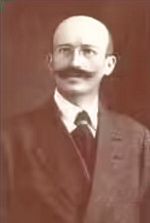American Bank Note Company print runs
The American Bank Note Company produced the following notes. It produced a special vignette of the coat of arms of Guadalajara (C 888) and one of a view of Guadalajara for the reverses.
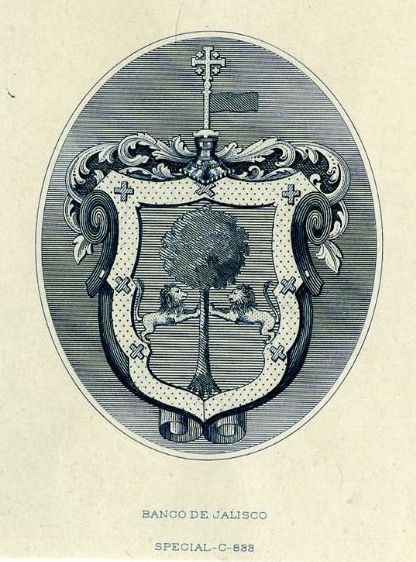
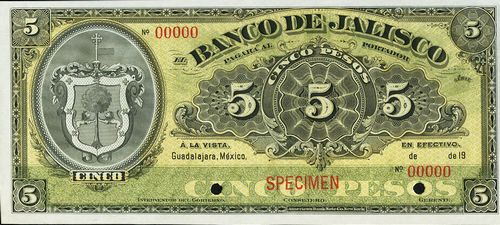
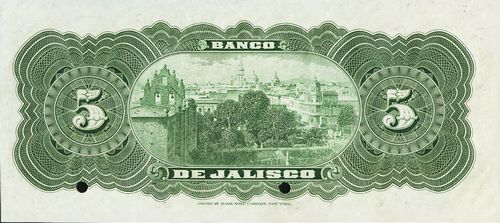 M385s $5 Banco de Jalisco specimen
M385s $5 Banco de Jalisco specimen
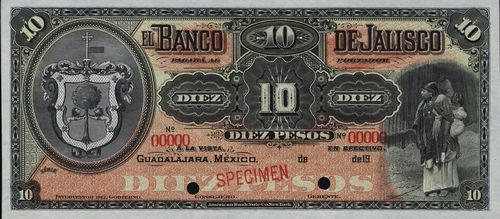
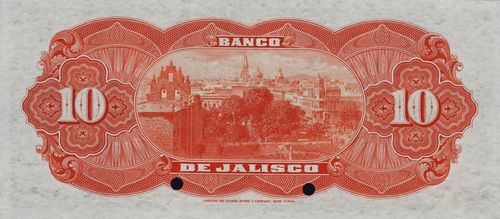 M387s $10 Banco de Jalisco specimen
M387s $10 Banco de Jalisco specimen
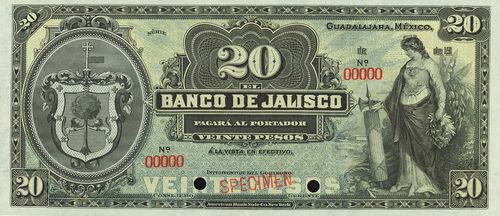
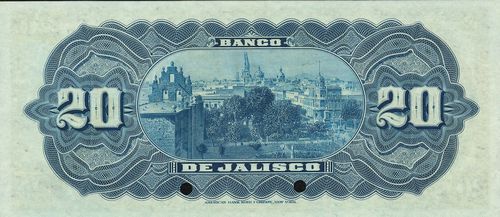 M388s $20 Banco de Jalisco specimen
M388s $20 Banco de Jalisco specimen
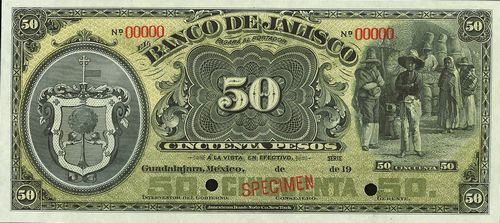
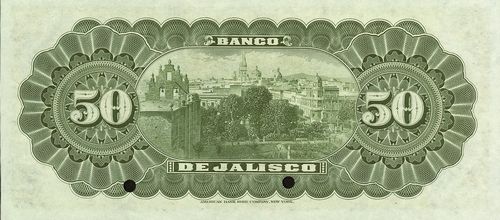 M389s $50 Banco de Jalisco specimen
M389s $50 Banco de Jalisco specimen
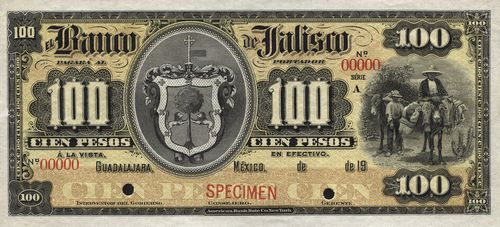 M390s $100 Banco de Jalisco specimen
M390s $100 Banco de Jalisco specimen
| Date | Value | Number | Series | from | to |
| March 1902 | $5 | 100,000 | 1 | 100000 | |
| $10 | 40,000 | 1 | 40000 | ||
| $20 | 15,000 | 1 | 15000 | ||
| $50 |
4,000 | 1 | 4000 | ||
| $100 |
1,000 | 1 | 1000 |
On 13 June 1908 the bank wrote to Leslie Hendriks, the Resident Agent in Mexico City, saying that it was going to place an order for 50,000 $5 notes, but wanted some colour sample as it thought it would be better to change the present green for one more vividABNC, folder 259, Banco de Jalisco (1907-1932. By 31 July the bank had selected their green and placed the order. They also asked the additional cost for changing the face plate: taking out the two fives which appear on each side of the centre and putting one large 5 in the centre. And they wanted to know if the ABNC would use the same paper as that used for the banknotes of the Banco Nacional de México. The ABNC made up a model with the changes, but on 26 August the bank placed their order, to be the same as the previous order without any changes.
| Date | Value | Number | Series | from | to |
| September 1908 | $5 | 50,000 | 1 | 50000 |
The ABNC sent the 50,000 $5 notes (C. 00001-50000) on 4 November 1908.
On 5 June 1909 Leslie Hendriks wrote that he had received an enquiry for 250,000 $5, 100,000 $10 and 50,000 $20 using the old plates and for 10,000 $100, 1,000 $500 and 500 $1,000, for which the ABNC would have to prepare new engravings. On 16 June the ABNC quoted prices, but reminded Hendriks of the fact (which it presumed the bank must know) that it already had a plate of the $100 note. However, it had given instructions to prepare models, which would be with multi-colour faces, using, as on the former notes, the coat-of-arms of Guadalajara. The vignette on the backs would be the view of Guadalajara, already used on all the other notes. The ABNC sent face and back models of all three denominations ($100, $500 and $1,000) on 30 June. Hendriks received them on 16 July and forwarded them to the bank.
On 28 July the bank placed its order, changing the quantities to 100,000 $5, 50,000 $10, 25,000 $20, 5,000 $100, 1,000 $500 and 500 $1,000 notes. The $5, $10 and $20 were to be printed on planchetted paper No. 27 and the balance on planchetted paper No. 25. As for the new models all the backs and the $1,000 face were approved. The $100 and $500 faces were not approved as the vignettes submitted were not appropriate (pulque is only produced in the States of México, Hidalgo and Puebla). On the $100 note the bank suggested the engraving of the Government Palace in Guadalajara and on the $500 notes the Falls of Juanacatlán, of which they enclosed postcardsproduced by the firm of Juan Kaiser, as shown by the imprint in the lower right corner, but they also requested to see stock vignettes of Commerce and Industry.
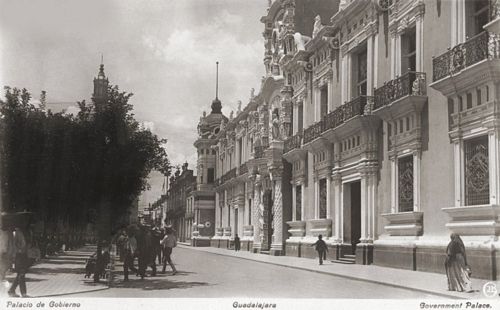
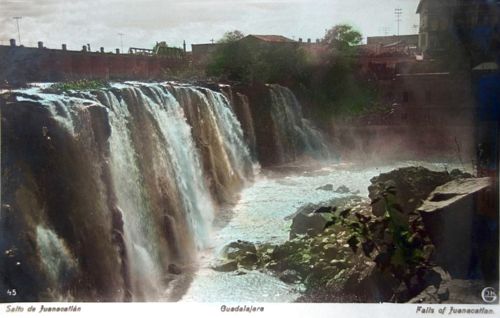
Hendriks remarked that, to his mind, the views were hardly suitable for the ABNC engravers to work from but, of course, if the bank decided on this extra work he could secure decent photographs. However. as, if it used these views, the ABNC would naturally have to change the face design entirely, he thought it would be better if they could use some of the company's "fine stock allegorical vignettes". He asked the ABNC to give the additional cost for the two special vignettes and to send several stock vignettes for the bank to choose from should they decide against the extra expense.
On 16 August the ABNC acknowledged the order, and posted face models for the $100 and $500 with new vignettes. It added that, if the bank wanted special vignettes it would need better photographs then the one shown on the post cards, as the Government Palace did not show at all. However, it would rather not have to engrave new vignettes, and would appreciate it if Hendriks could get the bank to accept the models, as the Engraving Department was pretty well filled up for the present.
To avoid confusion, on 1 September the bank authorised the ABNC to destroy the old plates for the $100 note and they were destroyed on 4 November. The same day, 1 September, the bank approved the models that the ABNC had sent, giving up on their wish to have the Palace of Government and Falls of Juanacatlán on their notes.
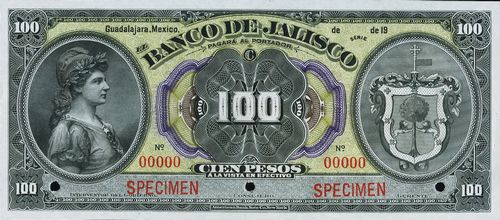
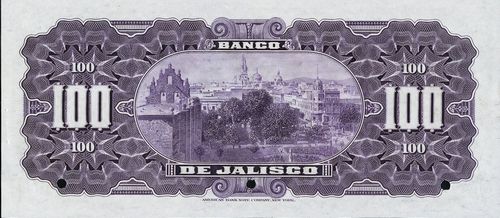 M391s $100 Banco de Jalisco specimen
M391s $100 Banco de Jalisco specimen
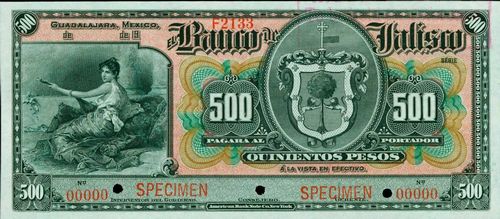
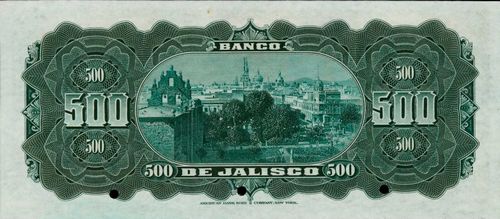 M392s $500 Banco de Jalisco specimen
M392s $500 Banco de Jalisco specimen
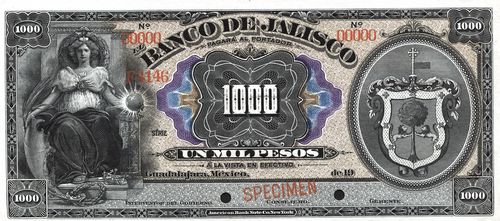
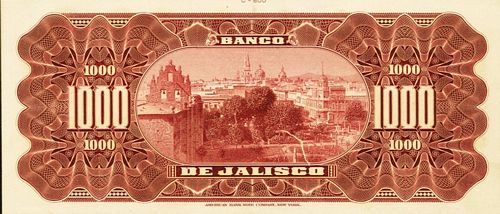 M393s $1,000 Banco de Jalisco specimen
M393s $1,000 Banco de Jalisco specimen
| Date | Value | Number | Series | from | to |
| August 1909 | $5 | 100,000 | 50001 | 150000 | |
| $10 | 50,000 | 40001 | 90000 | ||
| $20 | 25,000 | 15001 | 40000 | ||
| $100 |
5,000 | 1001 | 6000 | ||
| $500 | 1,000 | 201 | 1200 | ||
| $1000 | 500 | 151 | 650 |
On 7 January 1910 the ABNC shipped to José Ignacio Isusi, the bank’s agent in Tampico, Tamaulipas, by the steamer “Cienfuegos”, four cases containing 100,000 $5 (50001-150000), 50,000 $10 (40001-90000) and 25,000 $20 (15001-40000). Then, on 11 February it completed the order by shipping, per the steamer “Vigilancia” 5,000 $100 (1001-6000), 1,000 $500 (201-1200) and 500 $1,000 (151-650). On 1 March the bank acknowledged receipt of the second consignment and wrote that it was exceedingly dissatisfied with the notes, as the colours of the backgrounds were all different from those that they had selected “The result of this change being that the combinations of the colours are not worth looking at, and only the urgency there is for these notes prevents us from placing the same at your disposal.” The ABNC replied that “after carefully comparing the impressions of the printed notes as they were delivered with the original models, O.K.’d by you, we hardly feel that you are entirely fair. The colors are as near as possible the same as those on the original designs, the only difference being that they have of course more color, and are more distinct, - which naturally would give a little different appearance to the note. It is practically impossible to show on a sketch or model which is composed of different pieces of paper patched together, just how the note will look when the colors are printed.”
On 5 October 1910 the bank ordered 6,000 $5 notes. It asked for the dateline to be printed “Guadalajara, México”, leaving the necessary space blank, without placing as on the former ones, the prepositions “de” “de”, in order to ease printing of the dateABNC, folder 259, Banco de Jalisco (1907-1932). However, when Leslie Hendriks, the Resident Agent, said that this would probably require new plates, the bank wrote: “We suppose that you will be able to suppress the above without incurring the extra expense of a new plate, but if this is impossible, we prefer to have the notes come with the words that we intended to omit, as the expense of a new plate would not justify our reducing the amount of work in the printing office here. By all means, we trust that you will do all that possible to make the change without incurring the additional expense.” So, the bank decided to leave the change until it was necessary to make new platesibid..
| Date | Value | Number | Series | from | to |
| October 1910 | $50 | 6,000 | 4001 | 10000 |
These notes were forwarded on 19 December 1910ABNC, folder 259, Banco de Jalisco (1907-1932).
The bank was one of the first to contemplate issuing fractional notes, months before Huerta actually allowed this by modifying the Ley General de Instituciones de Crédito. On 1 April 1913 it told the Resident Agent that he could instruct New York to prepare models for $1 and $2 notes for the bank’s approval. At present the bank was not interested in 50c notesibid.. On 10 November Blackmore wrote asking whether, in light of Huerta’s decree, the bank was contemplating an issue, as he was expecting many requests from the other banks. The bank replied that it was not then thinking of making an issue, though a few months later it pursued the idea with Bradbury, Wilkinson and Co..
On 10 March 1914 the bank ordered a new issue of notes in seven denominationsABNC, folder 259, Banco de Jalisco (1907-1932).
| Date | Value | Number | Series | from | to |
| March 1914 | $5 | 60,000 | 150001 | 210000 | |
| $10 | 30,000 | 90001 | 120000 | ||
| $20 | 15,000 | 40001 | 55000 | ||
| $50 |
6,000 | 10001 | 16000 | ||
| $100 |
3,000 | 6001 | 9000 | ||
| $500 | 600 | 1201 | 1600 | ||
| $1000 | 200 | 651 | 850 |
At the same time the bank asked the ABNC to prepare models for $1 and $2 notes, in accordance with their own best judgement. These should be the same size as the Banco de Guanajuato’s notes. The $1 would have a vignette of the head of a lion on the face and the coat-of-arms (as on the $5 note) on the back, all other details being left to the ABNC’s judgement, The two values should be similar in design but with a great difference in colour. The bank wanted a price and delivery schedule for 300,000 $1 and 100,000 $2 notes. However, almost immediately, on 28 March, it cancelled the order for $1 notes (presumably because it decided that the Bradbury Wilkinson issues would suffice), though the Resident Agent told New York to continue preparing models for both the $1 and $2 values.
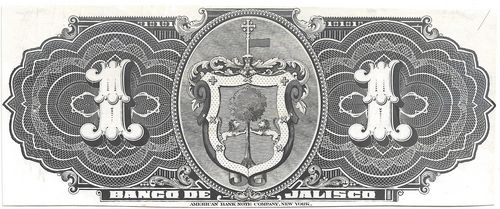 M384.3 $1 Banco de Jalisco pattern
M384.3 $1 Banco de Jalisco pattern
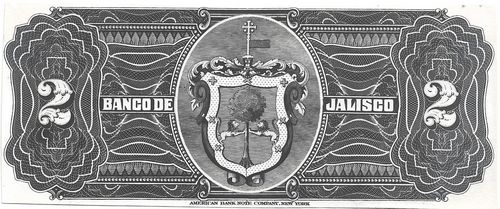 M384.5 $2 Banco de Jalisco pattern
M384.5 $2 Banco de Jalisco pattern
On 3 April the ABNC sent off face and back models of the proposed $1 and $2 notes, and the Resident Agent passed them on to the bank on 20 April.
On 27 April E. N. Gibbs told the order desk to stop all work on the $5 (F 4147), $10 (F 4145). $20 (F 4145) and $50 (F 4146) until further advised, presumably because the company was seeking at least a part payment before continuing work. He understood that lithographic transfers had been made on the first two denominations and no work on the last denominations. He told the department to finish up the $100, $500 and $1,000 notes and make ready for shipment. The bank instructed their Albert Stein, at the Banco Central Mexicano, to make a payment of $3,438.35 U.S., so on 4 May Gibbs told them to resume work.
On 7 May the bank acknowledged receipt of the models, which they liked, but said that they were refraining from formalising the order until circumstances normalised.
On 16 May the ABNC reported that the $100, $500 and $1,000 notes were ready for shipment, and paid in full. They expected to ship them on 21 May. However, the bank asked the ABNC to hold on to the notes for the time being. By 7 July all the denominations were ready for shipment, but the ABNC was holding on to them until further advised.
On 6 October 1914 the bank confirmed it had no plans to issue $1 or $2 notesABNC, folder 259, Banco de Jalisco (1907-1932).
Therafter, despite repeated requests, for years the bank would not make any decision as to the fate of the 114,800 notes held in the ABNC's vaults. Finally, in 1928, as the bank was in the process of liquidation, on 6 August, it gave permission to incinerate the notes and destroy the printing plates. The dies and platesThe die and plates were:
1 – 5 Pesos Face die (C 7552)
1 – 5 Pesos Back die (C 634)
2 – 5 Pesos Tint die #1 #2
1 – 6/5 Pesos Face plate #2 made on order F 4147
1 – 6/5 Pesos Back plate #2 made on order F 4147
1 – 10 Pesos Face die (C 7553)
1 – 10 Pesos Back die (C 635)
2 – 10 Pesos Tint die #1 & #2
1 – 4/10 Pesos Face plate made on order F 31
1 – 4/10 Pesos Back plate made on order F 31
1 – 20 Pesos Face die (C 7554)
1 – 20 Pesos Back die (C 636)
2 – 20 Pesos Tint die #1 & #2
1 – 4/20 Pesos Face plate #1 made on order F 31
1 – 4/20 Pesos Back plate #1 made on order F 31
1 – 50 Pesos Face die (C 7555)
1 – 50 Pesos Back die (C 637)
2 – 50 Pesos Tint die #1 & #2
1 – 2/50 Pesos Face plate #1 made on order F 31
1 – 2/50 Pesos Back plate #1 made on order F 31
1 – 100 Pesos Face die (C 10386)
1 – 100 Pesos Back die (C 798)
2 – 100 Pesos Tint die #1 & #2
1 – 4/100 Pesos Face plate made on order F 2133
1 – 4/100 Pesos Back plate made on order F 2133
1 – 500 Pesos Face die (C 10354)
1 – 500 Pesos Back die (C 799)
1 – 2/500 Pesos Face plate made on order F 2133
1 – 2/500 Pesos Back plate made on order F 2133
1 – 1000 Pesos Face die (C 10326)
1 – 1000 Pesos Back die (C 800)
1 – 2/1000 Pesos Face plate made on order F 2133
1 – 2/1000 Pesos Back plate made on order F 2133
were cancelled on 28 January 1929.
Signatures
The (identifiable) signatures are
Interventor
|
Manuel Gómez y Velasco was Interventor from the bank's inauguration in November 1898 until December 1906. He signed notes dated 1902 and 1903. |
 |
|
José Prieto Rivas was born in Guadalajara on 20 February 1864. He was appointed Administrador Principal del Timbre in Guadalajara in July 1896El Tiempo, 2 July 1896. He held this post until December 1906 when he resigned, partly for his health and partly to devote himself to his own personal affairs. He intended just to take over the post of Interventor from Gómez y Velasco, as this was less onerousLa Gaceta de Guadalajara, 16 December 1906. Less than a month later he announced that he was starting a new investment company with Manuel Aldrete Espinosa. Since both were “young, intelligent, well connected and in good condition to make a success of business” the newspaper thought they were certain to prosperLa Gaceta de Guadalajara, 20 January 1907. He signed notes dated 1908 to 1914. |
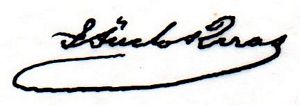 |
Consejero
|
Diego Moreno was an extremely wealthy man from Guadalajara, who owned numerous haciendas around Guadalajara. He was heavily criticized by his workers and partners, as he was accused of paying the worst wages of the time and of keeping several employees of the remotest haciendas imprisoned. However, due to his commercial importance he was chosen as part of the Constituent Congress of 1843 on behalf of Guadalajara, where he co-authored the Bases Orgánicas de la República Mexicana. He was elected President of the Casino Jalisciense in January 1899El Tiempo, 4 January 1899. He was appointed President of the Compañía Petrolera de Guadalajara, and later President of the Banco de Jalisco. Finally, he returned to his La Guaracha hacienda and died there on 2 December 1914. Moreno signed ABNC notes dated 1902. |
 |
|
Justo Fernández del Valle, with his brother Manuel, came from Graces, Asturias, Spain. They arrived in Guadalajara around 1865 and united with the Martínez Negrete family, each marrying a sister. From here they began to build their own businesses, accumulating a fortune and entering the tapatía (Guadalajaran) elite. Through the administration and disposal of the assets inherited by their respective wives, the Fernández del Valle bought the textile factories called La Escoba and Río Blanco, located north of Guadalajara. On 9 April 1877, the brothers bought the factory in La Escoba. To direct and manage it, on 7 May 1878 they formed the company "Fernández del Valle Hermanos". On 28 February 1885 they bought the Río Blanco factory. The Fernández del Valle's business strategy was to diversify their economic interests and obtain cash capital to invest in other activities; so on 10 December 1889 they formed the Compañía Industrial de Jalisco , with the participation of the following commercial houses also in Guadalajara: “Moreno Hermanos”, “Viuda e Hijos de Corcuera”, “Somellera Hermanos”, “Ancira y Hermano”, “Fortoul y Chapuy” and “Gas y Cogordan” (thus comprising of Mexican, Spanish and French interests) and sold half of the factories to their partners. However, the management of the factories remained in their hands. The Fernández del Valle were not only textile entrepreneurs; on 23 July 1880 they invested in the Ferrocarril de Guadalajara a San Pedro, an urban railway. They also invested in mining together with other partners: in August 1897 they founded the Compañía Minera La Asturiana, located in Etzatlán; in 1890 they bought half of the shares of the Compañía Minera de San Pedro Analco, in Hostotipaquillo; and in January 1891 they formed the Compañía Minera de la Luz y San Juan Nepomuceno, located in San Sebastián, all mines within the state of Jalisco, In the first attempt at a Banco de Jalisco, on 24 January 1884, the Fernández del Valle were going to invest $8,000 for 800 shares, but on that occasion the bank could not open its doors because it was prohibited by federal legislation. This sum, however, served them to participate as a shareholder in the Banco Nacional de México branch in Guadalajara that same year, in which Justo Fernández del Valle was the vice president of the Junta de Vigilancia. Later, in 1898, the Fernández del Valle participated in the definitive foundation of the Banco de Jalisco. As members of the board of directors of both banks they could have easy access to the bank loans with which they financed their other activities. In addition to industrial, mining and banking activities, the Fernández del Valle operated haciendas and ranches in Tepic, Jalisco and MichoacánIn Tepic they owned the haciendas of Mojarras; La Labor y San Leonel; and San Sebastián; the El Gavilán rancho, and the Potrero de los Bueyes. The hacienda of Buenavista, located in Michoacán, was owned by Josefa Martínez Negrete, Justo’s wife, owned the Buenavista hacienda, in Michoacán, and they also owned the hacienda of San Martín, in Jalisco, some from the assets inherited by their wives Rosalía and Josefa Martínez Negrete and others purchased by them during the marriage. In May 1887, President Porfirio Díaz granted Justo Fernández del Valle the exequator so that he could exercise the functions of consul of Guatemala in Mexico, in addition to those he already held as consul of Spain in the city of Guadalajara, while his brother Manuel was vice-consul, They also participated as members and founding partners of the Cámara de Comercio of Guadalajara in 1888 with Justo as its president. At the same time they were also members of the Cámara Agrícola Jalisciense. Justo signed notes dated 1902 and 1903. |
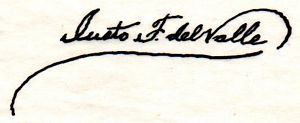 |
|
From 1890 to 1930, through L. Gas y Companía, Eugène Cuzin participated in the Compañía Industrial de Jalisco, the Compañía Industrial de Guadalajara, the Banco de Jalisco, the Compañía de Fomento y Bienes Raíces de Guadalajara and the Compañía Petrolera La Fortune, along with other French, Spanish and Mexican partners. He was also a director of the La Experiencia, Atemajac and El Salto factories in Jalisco, and he had under his orders the Hercules factories, in Querétaro, and Santa Rosa, in Orizaba. From 1905 he lived in a house that he had built on avenida Vallarta, which became the Consulate of France following his appointment as consul on 2 June 1911. By 1907 Eugène Cuzin was already the head of La Ciudad de México, while Antoine Gas returned to France. Anyway, the brothers Louis and Antoine Gas, Eugène Cuzin and his nephew Henri Teissier continued as partners. In 1907 Cuzin was the vice president of the Circulo Francés{footnotes}El Regional, 24 December 1906. In 1912 the Cuzin family moved to Los Angeles, California, for fear of the tremors that occurred in Guadalajara during that year. They lived there for three or four months, and then returned to Guadalajara. In 1913 Eugène bought a hotel on calle 16 de Septiembre to build a new store. Cuzin decided to retire to France that year, and prepared everything for his nephew Henri Teissier to succeed him in managing La Ciudad de México, together with his brother Jean Teissier. In May 1914 the Cuzin family again left for France. With the declaration of war, on 1 August 1914, Eugène Cuzin was enrolled in the ranks of the French army, but as he was very short-sighted he did not go to the front lines, but was sent to Mexico as consul of France, with the aim of recruiting the French of Guadalajara. Eugène traveled to Guadalajara but his family stayed in Grenoble, France, with some relatives. It was not until 1916 that Eugène returned, to meet his family. Cuzin spent two years in Mexico safeguarding the interests of his business, a time when he wrote the notebooks that make up his Diary. Eugène Cuzin returned to France and remained there from 1916 to 1917. The following year, Cuzin was still a partner of La Ciudad de México in Guadalajara. Cuzin died on 20 June 1930 in Paris worn down by the Mexican revolution, the European war and work. He appears as President of the Banco de Aguascalientes in 1912. He signed notes dated from 1908 to 1914. |
 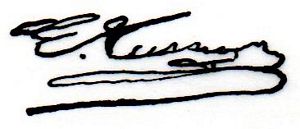 |
|
Aurelio González Hermosillo Aguilar was born in 1862 in Guadalajara, the son of Miguel González Hermosillo. He was a lawyer, hacendado and financier and served as President of the Banco de Jalisco and Vice-president of the Banco de Aguascalientes (in 1912). He was elected a diputado suplente to the XIX state legislature in November 1902La Voz de México, 12 November 1902 and a deputy in 1909La Gaceta de Guadalajara, 17 January 1909. In 1906 he built a large Italian style villa on the edge of Lake Chapala, designed and constructed by Angel Corsi, whom he brought from Europe. He owned the Estrella de Oro gold and silver mine in Chapala and the Hacienda de Santa Cruz del Valle, in Tlajomulco, just south of Guadalajara, that by 1818, had 6,000 hectares and produced basics such as corn, wheat and beans. He died in Guadalajara in 1929El Informador, 29 January 1930. He signed notes dated from 1908 to 1914. |
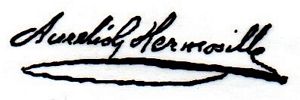 |
|
Augusto Brun was born on 31 July 1875 in Barcelonnette, and died in this same town on 14 November 1925, at the age of 50. Auguste Brun was a 21-year-old when he teamed up with Jean Laurens and in December 1899 Laurens Brun y Compañía joined three other firms of barcelonnettes to form the Compañía Industrial de Guadalajara. Laurens Brun y Compañía was restructured on 24 January 1905, with Antoine Brun, Auguste's younger brother, admitted as a new partner. As one of the French contingent of businessmen in Guadalajara Brun was elected Tesorero of the Círculo Francés in 1900El Universal, 17 August 1900 and 1901El Correo Español, 13 August 1901. He signed notes dated from 1909 to 1914. He appears on the board of the Banco de Aguascalientes in 1912. |
 |
|
Abraham Gallardo Maciel was born in San Miguel de Allende, Guanajuato, in 1854. In Guanajuato he owned the principal hardware businessThe Mexican Herald, 29 March 1906 and was the Presidente of the local Cámara de Comercio in 1897Semana Mercantil, 5 April 1897 and 1899El Tiempo, 1 February 1899; Semana Mercantil, 6 February 1899. In Jalisco he owned a hardware store and did property developmentsLa Gaceta de Guadalajara, 25 March 1906; The Mexican Herald, 29 March 1906. He was regularly elected to the local council in Guadalajara (from 1904 to 1910), and held office in the Cámara de Comercio. He signed notes dated from 1910 to 1911. He appears on the board of the Banco de Aguascalientes in 1912. He died in Guadalajara on 2 November 1931El Informador, 4 November 1931, aged 77 years old. |
 |
|
He appears on the board of the Banco de Aguascalientes in 1912. He signed notes dated from 1910 to 1914. |
 |
|
Antoine Brun was also born in Barcelonnette in 1876, so he was 29 years old when he joined Laurens Brun y Compañía, with the name changed to Laurens Brun y Compañía Sucesores. This company continued its activities until 30 July 1914. Antonio Brun was the manager of the casa comercial A. Brun y Cía. in 1910. In 1921 A. Brun y Cía. was the commercial agent of the General Transatlantic Company, which had steamers crossing the Atlantic, through the Panama Canal and visiting Pacific ports as far as San Francisco. He signed some $100 and $500 notes dated 5 January 1911. |
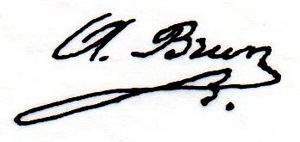 |
Gerente
|
Narciso Miranda was cashier of the Chihuahua branch of the Banco Nacional de México by July 1886El Siglo Diez y Nueve, 7 July 1886. On 1 July 1888 he was appointed cashier at that bank's new branch in OaxacaEl Siglo Diez y Nueve, 4 July 1888. He later became manager of the Oaxaca branch but resigned in October 1897El Imparcial, 29 October 1897; La Voz de México, 30 October 1897, presumably to become Director Gerente of the new Banco de Jalisco. He was elected as a deputy to the state legislature in November 1902La Voz de México, 12 November 1902 However, Miranda (and contador Ernesto Mora) were sacked on 4 April 1906 when an inspection revealed that they had defrauded the bank by creating false accounts and making loans to people who were notoriously insolvent. At an extraordinary annual general meeting on 9 October it was suggested that the amount involved was around $1,200,000La Gaceta de Guadalajara, Año IX, Núm. 41, 14 October 1906 and the total loss posted for 1905 was $816,920.17La Opinión, Veracruz, Tomo III, Núm. 701, 17 October 1906; El Diario, 21 October 1906. Miranda was appointed mamager of the brewery in Cuernavaca in December 1907Diario Oficial, Tomo XCIII, Núm. 35, 11 December 1907. He signed notes dated 1902 and 1903. |
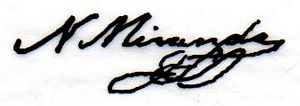 |
|
Gustavo Rochelt had been manager of the Banco de Aguascalientes and moved to the Banco de Jalisco in mid 1906 to replace Miranda. He signed notes dated 1907 and 1908. |
 |
|
H. Bartning He signed notes dated 1910 to 1914. |
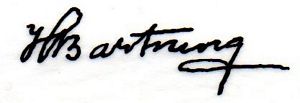 |

